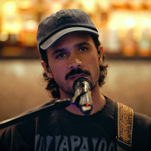The Best of December TV 2020 (i.e. Things That Happened After We Made Our Year-End Lists)

Poor December always gets left out of our Best of the Year considerations because you people (our dear, gentle readers) demand your lists in December itself. So to nominate, vote, prep, and publish on that schedule, we need a lead time that usually necessitates a November cutoff. It’s usually not much of an issue; in the past, not a lot of TV (or great TV) has premiered at the very end of the year. But with pandemic-pushed production schedules throwing everything out of whack, we wanted to mention a few shows, episodes, and performances that might have made our year-end lists if they had come out a little earlier.
However, not everything is strictly from December. We’ve made the space to discuss a few other niche bests as well. It’s our list, we do what we want!
Enjoy the Best of December(-ish) below, and in case you missed it here are the other Best TV Shows, the Best Episodes, and the Best Performances of 2020.
![]()
Kaley Cuoco, The Flight Attendant

The Flight Attendant was meant to be a launch title for HBO Max, but because of COVID-19 delays, ended up premiering later than expected. It made a splash anyway. The fanciful series follows, yes, a flight attendant (Kaley Cuoco) who gets caught up in an international conspiracy after a cute passenger she has a fling with in Bangkok ends up dead. Brutally murdered, actually, seemingly right next to her in the bed while she was blackout drunk. And yet, the series’ greatest trick is that despite the heavy subject matter—murder, addiction, childhood trauma, international espionage—it never feels dark. It can be emotional, sure, compelling (absolutely), but never dour. Most of that is down to Cuoco’s absolutely magnetic performance.
After her success on CBS’s The Big Bang Theory, Cuoco has not rested on her laurels; she’s made some exceptionally great choices to showcase her talents, but she does her best work here. It’s easy to understand why everyone loves, and yet it is still totally frustrated, by her character Cassie. She is a total mess but has a good heart, something Cuoco balances with expert comedic timing and knowing how to lean into pathos at just the right moments. (Plus, her hair, makeup, and wardrobe are absolutely aspirational). It’s funny to suggest that this, not her long-running juggernaut sitcom, is the true star turn for Cuoco, but it is. And thankfully, HBO Max has confirmed that there will be a Season 2. —Allison Keene
The Mandalorian: Grogu’s Puppeteers

The success of The Mandalorian hinges entirely on our collective love of Baby Yoda, aka The Child, aka Grogu. God bless Mando and Pedro Pascal’s face, but Grogu is everything. One of the reasons he has been so embraced is because he is tactile. He moves and interacts in this world in tangible ways—i.e. not CG (except for some necessary smoothing). He looks real. Ok he is real (in my heart). This expensive little puppet is also controlled by a number of apparently nameless puppeteers (I will enthusiastically publish their names if anyone will tell them to me!) They control all of his fine motor movements that make him so endlessly cute and compelling. Watch how his ears flicker slightly as his head turns and he blinks, opening his mouth to gurgle something (or eat a macaron) and raise a tiny clawed hand. Was there a greater moment on television this year than when Grogu put his little hand to Mando’s cheek? Did you not weep??
For all of the praise and obsession that Grogu gets, not nearly enough is paid to the actual craftsmanship of his tiny animatronic form nor those who control it (and our emotions). It also absolutely kills me that The Mandalorian has seen this much love when The Dark Crystal: Age of Resistance was full of incredible puppets but completely ignored. But credit where it is due, Grogu is special. And thank you, therefore, to the puppeteers that bring him to life so much so that his every move has been carefully documented in GIFs and memes because we just love him so. —Allison Keene
Kenny Omega and Don Callis (All Elite Wrestling, Impact Wrestling, and AAA)
Ever since AEW Dynamite launched on TNT in October 2019 fans have wondered when the phenomenally talented and theatrically-minded Kenny Omega would become the Kenny Omega of old—the cocky showstopper without a conscience who became one of the biggest wrestling stars in the world while working for New Japan Pro Wrestling. Omega’s rebirth began a couple of months ago, but fully took hold at the start of December, as he turned heel to win the AEW World title from Jon Moxley with the help of new manager Don Callis.
This is newsworthy not just because Omega won the championship or became the first person to defeat Moxley in AEW, but because Don Callis is in reality an executive with one of AEW’s rival companies, Impact Wrestling. Since winning the title Omega has made multiple appearances on Impact programming, reconnecting with two of his former Bullet Club stablemates from Japan, Karl Anderson and Doc Gallows, and routinely carrying the AEW title with him. It’s been rare for American wrestling promotions to cooperate ever since the territory system collapsed in the ‘80s, especially ones with a national TV deal as prominent as AEW’s, so this storyline instantly captured the attention of wrestling fans. Meanwhile, in the middle of December, Omega also wrestled a fantastic match with the Laredo Kid in AAA, one of the two major lucha libre companies in Mexico, the same night he made a taped appearance on an Impact show. So AEW’s champion appeared on two shows in one night, and neither one of them was an AEW show.
Omega’s AEW title reign is only a few weeks old but so far it’s been an intentional callback to the traveling champions that dominated wrestling before the death of the territories, as the arrogant, suit-clad Omega plays a modern-day version of Ric Flair or Nick Bockwinkel, with Callis as his J.J. Dillon or Bobby Heenan. It’s also led to ratings highs for both AEW and Impact, and opened up all manner of speculation over what other promotions AEW could wind up working with. It’s an unexpected direction for the still young AEW to head in as it enters its third year, but more proof that Tony Khan’s wrestling company is determined to set itself apart from Vince McMahon’s WWE. —Garrett Martin (Photo Credit: All Elite Wrestling)
Hilda Season 2

Hilda’s first season dropped on Netflix in 2018 without much fanfare or press, to the point where I hadn’t even heard of the show until a few weeks ago in the lead-up to its second season. When I finally sat down to check it out, I was immediately enamored by the series’ highly imaginative and mystical world, full of lovable characters, creatures, and locations for its protagonist to explore. The beautiful, often-breathtaking animation brings to life the soft, vibrant style of the graphic novels they’re based on. Upon watching its second season, I’m pleased to report that its return is even more delightful, quirky and deeply emotional than the first time around.
Hilda’s world, set in and around the city of Trolberg, has a highly specific, difficult vibe to explain: Its locations are mystical and often perilous, yet nearly every creature is adorable and has a sort of childlike attitude to the world. It’s usually the human adults who tend to cause serious problems for the series’ titular character, with the real dangers being the adults who try to stomp out its magic.
Hilda is about the joy and freedom of being a kid, and it captures the feeling of childhood passion and wonder better than most shows I’ve ever seen, bringing all these feelings rushing back regardless of the audience’s age. Underneath its gorgeous, silly surface is a layer of sadness and sentimentality that made me cry more than once, but that doesn’t mean its world is any less joyful. Just as the magical and mundane coexist in Trolberg, so does Hilda’s beauty and sadness.
It takes something special in order to make a show that can appear creepy, funny, cute and sad all at once, but whatever that something is, Hilda’s got it in spades. —Joseph Stanichar
Bridgerton

All hail Bridgerton, Netflix’s lush, swoony adaption of a set of romance novels that is the perfect way to close out 2020 (that is to say, thirsty). The series focuses on a London family with eight children, all of whom were blessed with good genes and five (or six?) of whom are currently of marriageable age. And thus, in this Regency-era setting, the game is afoot. There are balls and rakes and other things that had a completely different meaning in the 1800s, but one thing that has not changed is how electrifying the buttoning of a glove or the slight touch of hands can be in the right context. The show also gets pretty explicit at times, but does so with a nearly revolutionary female gaze for a period drama. As such, it is as pearl-clutching as one can get (and not a show to watch with one’s family). Bridgerton isn’t perfect, but it’s a candy-colored, gloriously anachronistic romp that brings a new vivacity to bonnet dramas (leaving most of the bonnets aside, for one), and is great fun. —Allison Keene
Steven Universe Future

Steven Universe is my favorite show, probably my favorite piece of media—ever. The reason why is deeply personal;, to the point where I often fear my rose-tinted glasses unfairly hide criticisms I would be more keen to point out in something that didn’t hold so much of my heart. Nonetheless, I can still say with confidence that Steven Universe is an excellent show for audiences of any age, and that Steven Universe Future, the 20-episode epilogue series which bid a teary farewell to the Crystal Gems earlier this year (and landed on DVD at the start of December), closes out the franchise with as much care and love as any fan could ask for.
Set after Steven Universe: The Movie’s two-year time jump, a now 16-year-old Steven Universe navigates a post-Diamond Authority galaxy and Earth, with multiple episodes taking time to examine the last burning questions fans had surrounding the show’s surprisingly deep lore and mysteries. The bigger challenge, however, is for Steven to learn how to navigate his own emotions and trauma.
Steven Universe has never shied away from serious discussions around mental health, but with an older central protagonist, Future is able to further delve into common problems relating especially to adolescence in a way that is respectful yet not somber. It maintains its silliness and energy while engaging in a dialogue about self-hatred and PTSD that few shows have managed to successfully pull off, yet this cartoon does so with style and grace. — Joseph Stanichar
For all the latest TV news, reviews, lists and features, follow @Paste_TV.








































